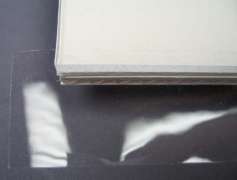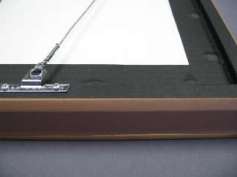By Jim Freeman, Associate Conservator and Framer
(Above) An example of the framing package before encapsulation.
When owners and caretakers of artwork want to properly house their treasured works, their collection may pass through The Center’s Custom Framing Department. Works on canvas, metal, wood, plastic and everything in-between are treated at The Chicago Conservation Center. Each work is individually assessed in order to determine the most appropriate type of housing, based upon the medium, the stability of the piece, the style and the client’s display concerns. A wide variety of housing options are available: traditional framing, custom mounts, and vitrines are the most common. Housing style, however, is only part of a successful equation: a professionally trained and knowledgeable framer using the most effective conservation materials is essential to the longevity of a piece of art. How will the use of proper conservation materials protect your collection, and alternately, what are the dangers of improper housing? Presented here are some basics concerning custom conservation framing.
The Effects of Improper Framing on Works of Art
There’s no room for experimentation with proper framing: less is more, and time honored matting, mounting and fitting techniques, in addition to the use of acid-free and conservation or archival materials, build the foundation of a safely housed work. The inclusion of conservation methods and the use of suitable materials evades potential damage caused by inappropriate framing, and can extend the life of the piece.
These problems are:
Direct contact between glazing and art: glass can adhere to the art and can cause injury to the piece when it is removed.
Use of acidic mating materials in housing: acid from framing materials can be transferred to the art through contact. This causes discoloration and brittleness.
Improper mounting: this can cause slippage, and art can become compromised.
Inappropriate glazing: old glass is generally not UV-protected, and light can cause discoloration of the work.
Unstable framing, fitting or wiring: structural instabilities can cause damage to the art when it is shipped or transported.
Improper wiring can cause a piece of art to fall off of the wall.
The Basics of Conservation Framing
The basic steps in conservation framing render the above problems mute.To ensure that your pieces will last for generations, make sure that your framer uses only high-quality conservation materials that will not have a lasting, negative impact on your artwork, including:
Acid-free mats and backboards
Fine quality Asian hinging papers
Reversible and neutral conservation adhesives
Dustcovers applied to the back of the frame to protect from environmental damage
Appropriate UV-filtering glass or acrylic glazing materials (While acrylic can offer greater protection from ultraviolet rays, it can also create static electricity which can harm materials such as pastels, chalk or charcoal)
Use mats or spacers to separate the artwork from the glass or acrylic glazing
Ensure that any mounting techniques used are reversible
Never cut an artwork to fit an existing frame; instead, choose a new frame better suited to the size of the piece
(Above) Art works with engaged mat, which creates space between the art and the glazing
(Above left) Encapsulation of the package with pH neutral tape to prevent foreign objects from migrating into the housing.
(Above right) Finished fitting: installation of proper hanging hardware is one of the last steps in stabilization.





